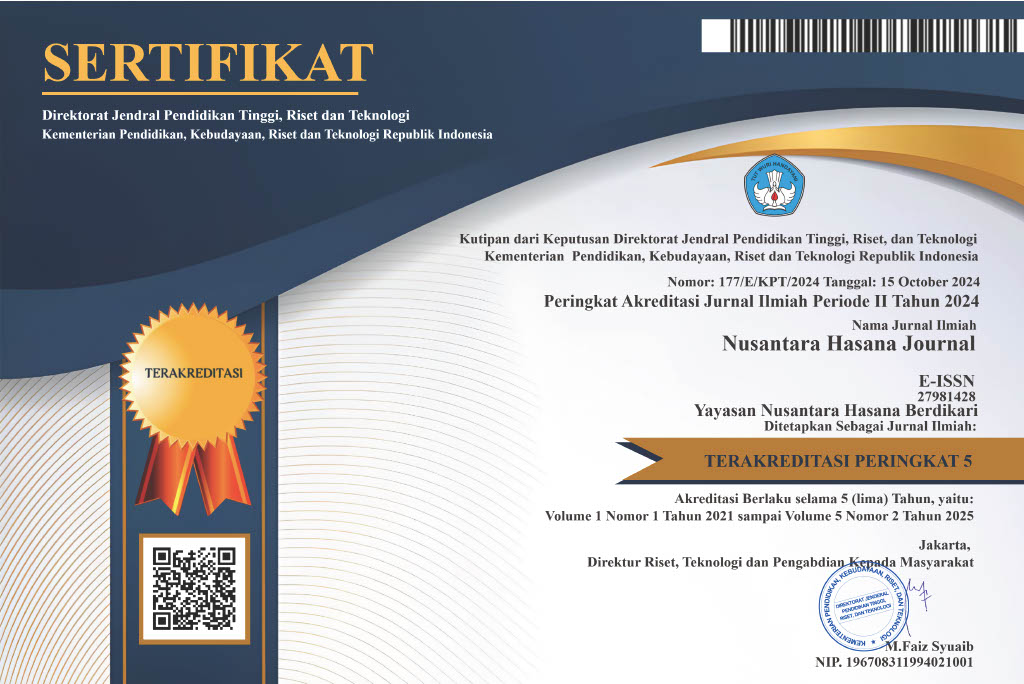UJI pH DAN ORGANOLEPTIK SUSU SAPI PASTEURISASI DENGAN PENAMBAHAN BIJI CHIA
DOI:
https://doi.org/10.59003/nhj.v5i2.1558Keywords:
cow's milk, pasteurization, chia seeds, pH, organolepticAbstract
This study aimed to determine the effect of adding chia seeds (Salvia hispanica L.) on the organoleptic quality and pH of pasteurized cow's milk, and to determine the optimal concentration acceptable to consumers. The study was conducted in Sumberadi Village, Kebumen District, Kebumen Regency, from May to June 2025 using a Completely Randomized Design (CRD) with four treatments (0%, 1%, 2%, and 3% chia seeds) and four replications. Parameters tested included color, aroma, taste, texture, preference, and pH. Organoleptic testing was conducted by 20 semi-trained panelists using a four-level hedonic scale. The results indicated descriptive changes in sensory characteristics and pH due to the addition of chia seeds, particularly in color, taste, and texture. However, statistical analysis (ANOVA) showed no significant effect (p > 0.05) on any of the tested parameters. The pH tended to decrease with increasing chia seed concentration, but remained within safe limits. Treatment P0 achieved the highest score, while P1 demonstrated the best texture results, still acceptable to panelists. In conclusion, chia seeds can be added to pasteurized cow's milk at a maximum concentration of 1% to produce a product that maintains functional value without compromising the milk's sensory quality and pH.
Downloads
References
Ayerza, R., & Coates, W. (2005). Chia: Rediscovering a Forgotten Crop of the Aztecs. University of Arizona Press.
Buck, B. L., Azcarate-Peril, M. A., & Klaenhammer, T. R. (2010). Role of probiotics in food quality and sensory characteristics. Journal of Dairy Science, 93(5), 2163–2171.
Coorey, R., Tjoe, A., & Jayasena, V. (2014). Gelling properties of chia seed and flour. Journal of Food Science, 79(5), E859–E866.
Grancieri, M., Martino, H. S. D., & Gonzalez de Mejia, E. (2019). Chia seed (Salvia hispanica L.) as a source of proteins and bioactive peptides with health benefits: A review. Comprehensive Reviews in Food Science and Food Safety, 18(2), 480–499.
Hariyadi, P. (2000). Dasar-dasar Teori dan Praktek Proses Termal. Pusat Studi Pangan dan Gizi IPB, Bogor.
Hrnčič. M. K., M. Ivanovski, Cör and Ž. Knez. 2019. Chia Seeds (Salvia hispanica L.): An Overview—Phytochemical Profile, Isolation Methods, and Application. Molecules 2020, 25: 11.
Ixtaina, V. Y., Nolasco, S. M., & Tomás, M. C. (2011). Physical properties of chia (Salvia hispanica L.) seeds. Industrial Crops and Products, 33(2), 287–291.
Ixtaina, V.Y., S. M. Nolasco, and M. C. Tomas. 2008. Physical properties of chia (Salvia hispanica L.) seeds. Industrial Crops and Products, 28(3): 286–293.
Safari, A., F. Kusnandar, dan E. Syamsir. 2016. Biji Chia: Karakteristik Gum dan Potensi Kesehatannya Chia Seeds: Mucilage Characteristic and Its Health Potential. Pangan, 25(2): 137 – 146.
Ulbricht, C., Chao, W., Nummy, K., et al. (2009). An evidence-based systematic review of chia seed (Salvia hispanica) by the Natural Standard Research Collaboration. Journal of Dietary Supplements, 6(4), 379–408.
Uzunova, G., M. Perifanova-Nemska., Zh. Petkova., St. Minkova, and Kr. Nikolova. 2019. Physicochemical characteristic of chia seed oil from Peru. Bulgarian Chemical Communications, 51(Spec.Iss.D): 217 – 220.
Downloads
Published
How to Cite
Issue
Section
License
Copyright (c) 2025 Ngafifah Mamluatunnajah

This work is licensed under a Creative Commons Attribution-NonCommercial-ShareAlike 4.0 International License.
NHJ is licensed under a Creative Commons Attribution-NonCommercial-ShareAlike 4.0 International License.
Articles in this journal are Open Access articles published under the Creative Commons CC BY-NC-SA License This license permits use, distribution and reproduction in any medium for non-commercial purposes only, provided the original work and source is properly cited.
Any derivative of the original must be distributed under the same license as the original.
























